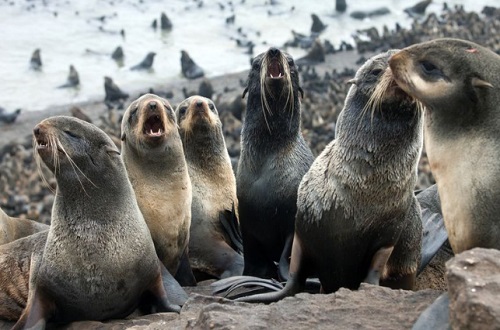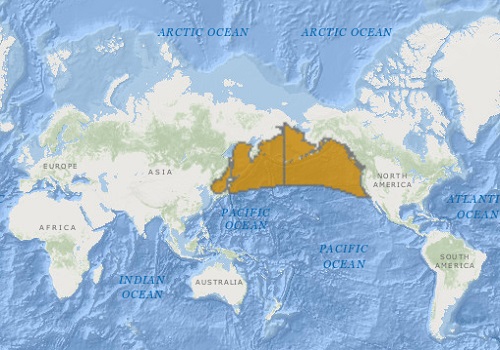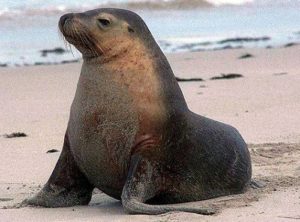
Northern fur seals have been hunted by indigenous people for thousands of years as a source of food and clothing.o
o
Interesting facts
- Of the 9 species of fur seals in the world’s oceans only the Northern fur seal lives in the northern hemisphere.
- Northern fur seals are more closely related to sea lions than to true seals, both have external earflaps, which true seals lack. They also have the ability to walk on all fours.
- These marine mammals are philopatric meaning that they return to breed and give birth where they were born.
- The Guadalupe fur seal range overlaps slightly with the Northern fur seal in its southern range in California.
Name
- Scientific name: Callorhinus ursinus
- Common name: Northern Fur Seal

Conservation status
- The Northern fur seal is considered “vulnerable” by the International Union for the Conservation of Nature (IUCN).
- This species is no longer protected by any international treaty which elapsed in 1984. It is not even listed under CITES.
- In Canada it is protected by the Marine Mammal Regulations of the Fisheries Act, which protects the species against hunting or disturbance, except for subsistence use.
- In the United States the The Alaska Regional Office of NOAA Fisheries is responsible for the protection, conservation and management of North Pacific and Bering Sea northern fur seals.
Population
- The global population of the species is estimated at 1.29 million in 2014. In the 1950s its population was estimated at 2.5 million. Its current population trend is decreasing.
Distribution and Habitat
- Northern fur seals have a wide geographic range throughout the northern Pacific Ocean, Sea of Okhotsk, Bearing Sea and Sea of Japan.
- Their northern range limit is the Beaufort Sea in the Arctic.
- Their southern range limit in the eastern Pacific is Baja California and in the western Pacific the Sea of Japan.
- Breeding grounds are on Pribilof Islands, Commander Islands and Bogoslof Island in the Bering Sea, San Miguel Island in California, Tyuleniy Island and Kuri Islands in the Sea of Okhotsk.
- Northern fur seals are found most of the time 50 to 100 miles offshore except during breeding season.
- These marine mammals migrate to rocky islands or to the continental shore during breeding season in the summer.

Northern Fur Seal Distribution map. Source: IUCN
Physical description
- The color of an adult reflects its age, gender and activities.
- Northern fur seals are born black, after 4 months they molt and become gray.
- Females and young pups have gray coats. Females can also have a reddish-brown patch on the chest. Older males have brown-black coats and they also develop short manes.
- Underneath their coats these marine mammals have a thick underfur which works as insulation against the frigid waters of the Pacific Ocean.
- They have external ear flaps which distinguishes them from true seals.
- Their hind flippers can turn to face forward giving them the ability to walk on all fours and mobility on land.
Size and Weight
- There is a larger than usual sexual diphormism between males and females in this species, meaning that males are unusually larger and heavier than females.
- Females can range from 88 to 110 lb (40 to 50 kg) and males from 397 to 606 lb (180 to 275 kg).
- The average length for females is 4.66 ft (1.42 m) and for males 7 ft (2.13 m).
Reproduction
- Northern fur seals are polygynous, meaning that males and females have multiple mating partners.
- Females reach sexual maturity between 4 and 6 years old while males between 8 and 10.
- At around May male Northern fur seals start arriving at their place of birth which is their breeding site in order to secure territory. Females arrive in mid-June to give birth to offspring conceived the year before.
- Peak mating occurs from late June to late July.
- The fertilized egg in the female undergoes a 4 month delayed implantation which ensures the timing of birth at the same time the following year.
- Males do not feed during breeding period, some loose as much as 20% of their weight.
- Within two weeks of giving birth females will mate again.
- The stronger males secure larger number of females
- Females lactate their pups for up to ten days before returning to feed at sea during the night. They stay for four to ten days, return to feed the pup for two days and return to the sea. They will continue to do this for around four months until late October when they leave their pups on their own.
Social Behavior
- Northern fur seals spend their winter feeding in the waters of the Northern Pacific Ocean.
- During the summer months they migrate to breeding grounds on rockeries. Females give birth to pups conceived the year before and breed.
- Males show aggression against other males during breeding.
- After the summer on land they migrate south.
- These marine mammals are not a very social species. They swim in groups but feeding is solitary.
- No social bond is developed between males and females.
Diet
- Northern fur seals are opportunistic feeders, they feed mainly on fish, squid, plankton and eel.
- Feeding behavior is solitary.
Threats
- These marine mammals are preyed by sharks and killer whales. The calves are preyed by sea lions, leopard seals and Arctic foxes.
- Higher death rates are being reported by entanglement in fishermen nets.
Taxonomy
 Kingdom: Animalia
Kingdom: Animalia- Phylum: Chordata
- Class: Mammalia
- Order: Carnivora
- Clade: Pinnipedia
- Family: Otariidae
- Genus: Callorhinus
- Species: Callorhinus ursinus
References and further reading
- International Union for the Conservation of Nature (IUCN) – Callorhinus ursinus
- University of Michigan Museum of Zoology – Callorhinus ursinus Northern fur seal
- DigiMorph University of Texas at Austin – Callorhinus ursinus
- National Oceanic and Atmospheric Administration Fisheries – Northern Fur Seal (Callorhinus ursinus)
- Fisheries and Oceans Canada
- The Marine Mammal Center – Northern Fur Seal
- The Alaska Regional Office of NOAA Fisheries
- Committee on the Status of Endangered and Wildlife in Canada – Assessment and Status Report on the Northern Fur Seal Callorhinus ursinus)
- The Alaska Regional Office of NOAA Fisheries